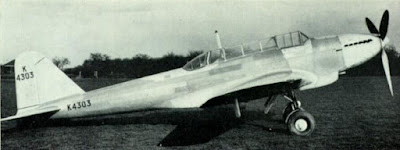The prototype of the Fairey Battle, K4303, first flew on March 10, 1936. It had been designed by Marcel Lobelle and made at Hayes. It was powered by a 1,030-HP, Rolls Royce Merlin I engine, driving a three-bladed propeller. It entered service in June 1937 after more than a year of test flights. The first 136 aircraft that rolled out of the Fairey factory were equipped with the Merlin I engine. However, this machine would soon be replaced with a Merlin II, and later with a Merlin III, which generated 1,250 HP. A total of 2,201 light bombers were produced.
Technical Characteristics
The Fairey Battle was a single-engine, low-wing monoplane. The slim, oval section fuselage was built in two portions. The part forward of the pilot's cockpit was made up entirely of steel tubes, which were bolted and riveted together, while the rear portion was a metal monocoque that consisted of hoop frames, stamped out in one piece and Z-section stringers, and core jigs. The wings were cantilever and of two-spar construction. Landing gear was retractable.
Specifications (Mk. III)
Type: light bomber
Length: 12.90 m (42 feet, 4 inches)
Wing Span: 16.46 m (54 feet)
Wing Area: 39.2 m2 (422 square feet)
Height: 4.72 m (15 feet, 6 inches)
Powerplant: one 1,250-HP, Rolls Royce Merlin III, 12-cylinder, 'V'-shaped piston engine.
Maximum Speed: 414 km/h (257 mph)
Range: 1,600 km (1,000 miles)
Rate of Climb: 4.70 m/s (925 feet/minute)
Armament: two 7.7mm machine guns, with one firing forward, and the other firing backward on flexible mount in rear fuselage. Four 110-kg bombs internally, or 650-kg of bombs externally.
Below, the Fairey Battle swooping down out of the sky.
Below, the Fairey Battle in 1939 flying over the English channel.
Below, view of underside of aircraft as it climbs up steeply during tests.
Below, the prototype K4303 in 1936.




